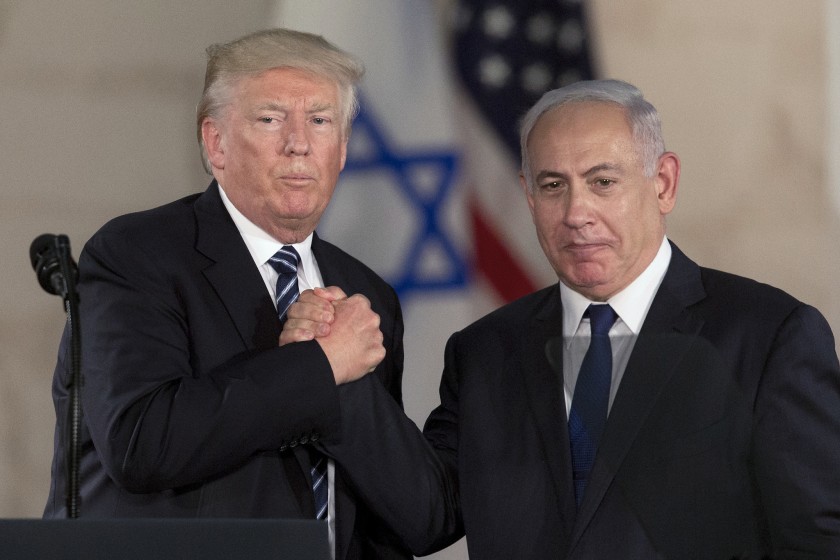Originally appeared at Newsweek
June 9, 2020
President Trump has always shown unflinching courage in international affairs—except when it comes to the “Deal of the Century” plan for peace between Israel and the Palestinians.
Going head-to-head against the world’s other great superpower, China, the U.S. president fought its unfair trading practices and called it out for coronavirus deception. Trump stared down nuclear North Korea, bringing the isolated state into unprecedented negotiations. And despite European uproar and Persian sword-rattling, President Trump overturned the Obama administration’s conciliatory Iranian nuclear deal, enacted tough sanctions on the mullah regime and even ordered a strike against famed Revolutionary Guard general Qassem Suleimani.
Similarly, in the Middle East, Trump took giant strides. The president moved the U.S. embassy in Israel to Jerusalem, officially recognized the Golan Heights as sovereign Israeli territory and pushed back on international organizations with long records of anti-Israel bias.
Abbas to Trump: “May your house be destroyed!”
The PA is an oppressive, thuggish gang that pays monthly salaries for the murder of Israelis. Arafat Irafaiya, who raped and murdered 19-year-old Ori Ansbacher while she was on a walk in February, is on the PA payroll, as is the family of Mohammad Nasser Tra’ayra, who stabbed to death 13-year-old Hallel Ariel as she was sleeping in her bed after a dance recital.
The same PA is also an enemy to Trump himself. On January 28, PA President Mahmoud Abbas called the president a “dog, son of a dog” and cursed him with the Arabic slur, “May your house be destroyed.”
For all these reasons, it seemed obvious that Trump’s policy revolution, and his hawkish administration, was going to dismantle the PA—not buttress it.
The recurring failure of two-state is back.
With the rise of the Trump administration, pundits on the Left and Right alike predicted the death of the “land for peace” paradigm, whereby Israel gives away parts of the Jewish ancestral homeland to create an independent Palestine. Previous attempts toward this so-called “two-state solution”—the Oslo Accords and the Gaza Disengagement chief among them—ended miserably when newly acquired PA-controlled land mutated quickly into attack zones against the Jewish state.
So when the “Deal of the Century” came out, it surprised analysts by offering up an exceedingly familiar formula: The PA would take control of a sizable chunk of the Israeli heartland.
On the other hand, the “Deal” was supposed to also be a big endorsement of Israeli historical rights in Judea and Samaria (the “West Bank”), with roughly 30% of the land becoming officially recognized as Israeli-controlled. Almost all the Israeli presence in the West Bank would be fully legalized—a huge revolution, indeed!
Empty demands on the Palestinians.
Within the pro-Israel community, “Deal of the Century” advocates point to the strong stipulations blocking the formation of a Palestinian state until the conditions are met, including the demand to recognize Israel as a legitimate Jewish state, cease paying terrorists and their families, end anti-Israel incitement and demilitarize.
While this is an attractive option, it is also dangerous. The text of the plan and its maps unambiguously call for establishing a Palestinian state. If Israel agrees to this framework, the small Jewish sovereignty enclaves could soon be surrounded by a much bigger Arab one. PA control of the land will mean rockets, terror tunnels and explosive balloons—a Gaza Strip in the highlands surrounding Jerusalem and overlooking Tel Aviv.
Moreover, who is to say how the “Deal” will be interpreted in the years to come? A future U.S president could easily place emphasis on the creation of a Palestinian state, noting that even Israel’s greatest supporter—President Trump—believed in the idea.
A good place for U.S. diplomacy to stop.
With COVID-19 striking at the U.S. economy and riots breaking out in America’s cities, President Trump needs a win in Israel—not another headache. But the “Deal” is no panacea, it will not bring peace to the Middle East and it will not bring votes in November. Indeed, Trump’s evangelical Christian base was largely disappointed with the plan that called for an Arab state in the Holy Land.
But there is another way. In November, prior to the release of the plan, Secretary of State Mike Pompeo announced that “the establishment of Israeli civilian settlements in the West Bank is not, per se, inconsistent with international law.” With this statement, the U.S. reversed previous policy, declared its support for Israeli life in historic Judea and Samaria and tacitly backed the assertion of Israeli sovereignty at any time.
President Trump’s policy revolutions have brought more security and stability to the Middle East. Exactly because of these gains, and the values that lay behind them, it would be a profound historical misstep for the Trump administration to be remembered as resurrecting the dangerous two-state concept instead of finally burying it.
Yishai Fleisher is the international spokesman for the Jewish Community of Hebron.
The views expressed in this article are the writer’s own.










